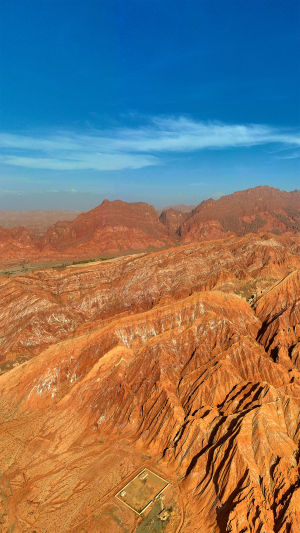There is an authoritative website that has selected the world's top five geological wonders. It can be said that these are the most astonishing landscapes unlike anything on Earth, each representing a realm of extraordinary human imagination.
1. The Mysterious Stone Wave, located at the border of Utah and Arizona, USA, was formed during the Jurassic period, around 190 million years ago. It evolved from dunes shaped by the forces of sandstorms and natural weathering.
In a small area of less than 200 square meters, the blood-red sandstone forms waves that seem to tumble, creating a breathtaking combination of rigidity and softness. This awe-inspiring formation is aptly named the Stone Wave.
The formation process of this amazing stone wave has sparked debates among scientists. Some argue that it was formed by prehistoric floods washing into the area, while others believe it was the result of millions of years of endless polishing by massive sandstorms.
According to modern historical research, the Stone Wave has a history of 190 million years. It is believed that sediment from the ancient Rocky Mountains accumulated here and transformed into sandstone over thousands of years.
Through geological movements and increasing pressure underground, the sandstones fractured and transformed into a canyon. Over time, relentless sandstorms and erosion from rainwater shaped the canyon into the magnificent wonder we see today.
2. Antelope Canyon, located in the Navajo Native American Reservation in northern Arizona, is one of the world's most renowned slot canyons and is considered one of the top ten geological wonders globally. Lower Antelope Canyon is known as "Hasdeztwazi," which translates to "arched spiral rock." Lower Antelope Canyon is closed to the public for approximately nine months of the year.
The main rock formation in Antelope Canyon is Navajo Sandstone, which is visibly prominent. Over an extended period of geological evolution, the sandstone layers comprised rock fragments of various sizes. These sandstone layers are softer than metamorphic or volcanic rocks, making them more susceptible to erosion by wind and water. Antelope Canyon features a narrow opening that allows flash floods to rush through with incredible force.
The constriction of the channel intensifies the vertical erosion, resulting in significant changes to the landscape over time. Ultimately, this process formed the stunning corridor at the bottom of Antelope Canyon.
3. Blue holes are peculiar phenomena found occasionally near the surface of certain oceans worldwide. They appear as round, deep blue areas contrasting with the surrounding light gray islands, leading people to imaginatively call them "blue holes" or the "pupil of the ocean."
These blue holes have distinct distribution and types on Earth, such as the "Eye" of the South China Sea, known as Dragon Cave, the heart of the atoll called Big Blue Hole, the diving resort named Dean Blue Hole, and the Castle of Life, which refers to the Blue Hole of Dean in the Red Sea. Blue holes typically have circular shapes with steep and concave walls. Their deep blue color results from the stark contrast between the deep waters and the light blue hues of the surrounding shallows.
Most blue holes contain a combination of fresh and saltwater. The point where these two types of water meet within a blue hole is known as the salt leap layer. This layer is highly susceptible to erosion, shaping the rocks within the blue hole. These geological wonders are usually found above shallow water carbonate terraces.
4. The "Eye of Sahara," situated in the southwestern region of the Sahara Desert, the largest desert in the world, consists of flatlands and small hills. It earned its name because it resembles a mysterious "giant eye" embedded in the desert.
This geological wonder has a diameter of approximately 48 kilometers, and its distinct "eye" shape is visible from hundreds of kilometers above in space. The discovery of this "eye" occurred accidentally during a U.S. manned space mission in the 1960s when astronauts were amazed by the sight and exclaimed, "There is a round thing in the Sahara desert, it seems to be like an eye, looking at itself."
5. The "Giant's Causeway" is a coastal rocky path stretching over 5 kilometers and consisting of more than 40,000 basalt columns of varying heights. According to Northern Ireland legend, this remarkable formation was created by a "giant," hence its name. It is located on the headland at the edge of the Antrim Plain in Northern Ireland, part of the United Kingdom.
Nature is an enigmatic and inexplicable realm that not only presents us with beautiful and vibrant landscapes but also nurtures countless living organisms. These geological wonders showcase the magnificent diversity and astonishing formations found throughout the world, inspiring awe and curiosity in those who have the opportunity to witness them firsthand.





